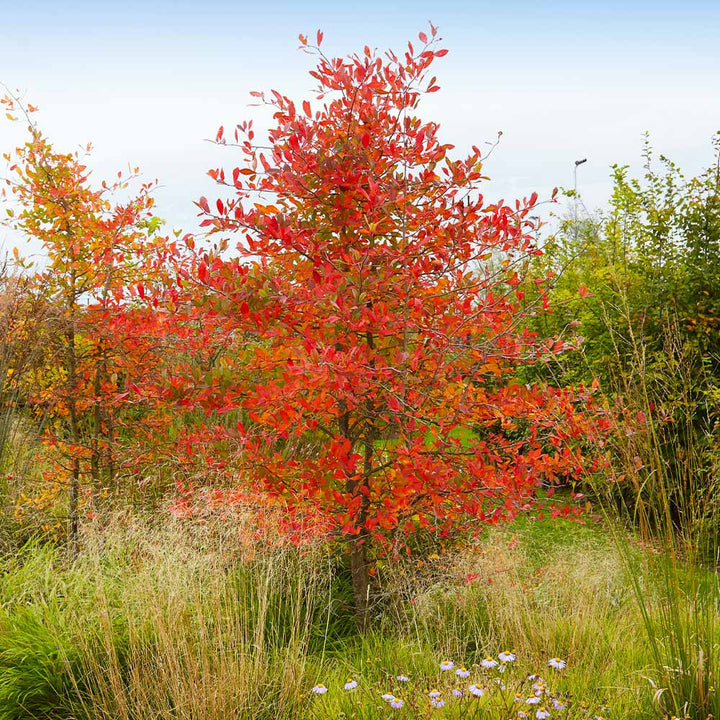
Or, simply allow your local songbirds to strip the harvest quickly. Native Americans and early settlers enjoyed eating these berries and were thought by some to have medicinal properties. You can eat these berries raw, or bake them in pies or cook them into delicious jams. You'll get a sense of the flavor of the pretty, edible berries with the nicknames Sugarplum and Wild-Plum. Serviceberries look like large, dark blueberries. They finally mature a deep, rich purple in early summer. Soon, you'll see the flowers give way to small green berries that gradually deepen into red. This outstanding flower display is a wonderful harbinger of the growing season and supports the early nectar needs of beneficial pollinators. In spring, you'll appreciate the delicate, fine-textured clusters of white flowers which simply cover this tree. Nicknames include Shadbush and Juneberry, named for the annual summer time frame of the ripe berries. George Washington planted this enchanting species at his estate, Mount Vernon.Ī natural hybrid of several Serviceberry varieties, Autumn Brilliance Serviceberry offers a lovely landscape display all year-long. Design-savvy, they also expect a gorgeous presentation in all seasons.Ī perfect choice for gardens across the country, Autumn Brilliance Serviceberry (Amelanchier x grandiflora 'Autumn Brilliance') is a versatile and popular shrubby fruit tree. 82 pp.With an enduring interest in native trees, Americans are seeking out plants that support local wildlife and deliver edible crops. Fish & Wildlife, Chesapeake Bay Field Office, Annapolis, MD. Native Plants for Wildlife Habitat and Conservation Landscaping, U.S.
#AUTUMN BRILLIANCE TREE MANUAL#
Manual of Woody Landscape Plants: Their Identification, Ornamental Characteristics, Culture, Propagation and Uses, Fifth Edition. Serviceberries are a host plant for a variety of moths, which, in their caterpillar form, provide essential food for young birds. The berries provide food for a variety of bird species including American Robins, Baltimore Orioles, Cedar Waxwings, and Gray Catbirds. The early flowers provide pollen and nectar to a variety of native bees and other beneficial insects such as syrphid flies and tachinid flies (which are good predators of pests). Wildlife: Serviceberries are highly valuable to native wildlife. Lace bugs and spider mites sometimes can be a problem also. Disease severity varies from year to year, in part due to weather conditions. They are also susceptible to fire blight, occasionally. Serviceberries are susceptible to cedar-quince rust disease, which can render the fruits inedible for people (but still useful for wildlife). They are among the earliest-flowering spring trees. This is an excellent alternative to the invasive ‘Bradford’ callery pear. In general, serviceberries have attractive early spring flowers, edible fruits (similar to blueberries), and brilliant orange-red foliage colors in autumn. All are fine choices for gardens and landscapes where a small tree or large shrub is desired. Serviceberry species can be difficult to distinguish from one another. x grandiflora ‘Autumn Brilliance’, is noted for its outstanding orange to red autumn color. Apple serviceberry (Amelanchier x grandiflora) is a hybrid cross between A.Cultivars such as ‘Cumulus’ and ‘Snowcloud’ have good potential for street tree use. Allegheny serviceberry (Amelanchier laevis) is found in the Piedmont and Mountains and is less likely to sucker compared to A.Downy serviceberry ( Amelanchier arborea) is native to the Piedmont and Mountain regions and grows as a short-trunked small tree or multi-stemmed shrub with a vase-like form.It is adapted to all soil textures, including clay and sand. Its natural form is a multi-stemmed shrub that spreads by suckering (new stems arise from the root system). This is the most common in Maryland’s three ecoregions: Mountain, Piedmont, and Coastal Plain. Shadblow serviceberry or shadbush (Amelanchier canadensis).Garden Uses: While there are 13 species of serviceberry documented in Maryland, the most common ones available to home gardeners are: Soil: moist, well-drained, acidic, pH 5.5-7.5

Maryland Distribution: Native habitat varies by species (see below)įlowers: showy white flowers in late March-April-May


 0 kommentar(er)
0 kommentar(er)
